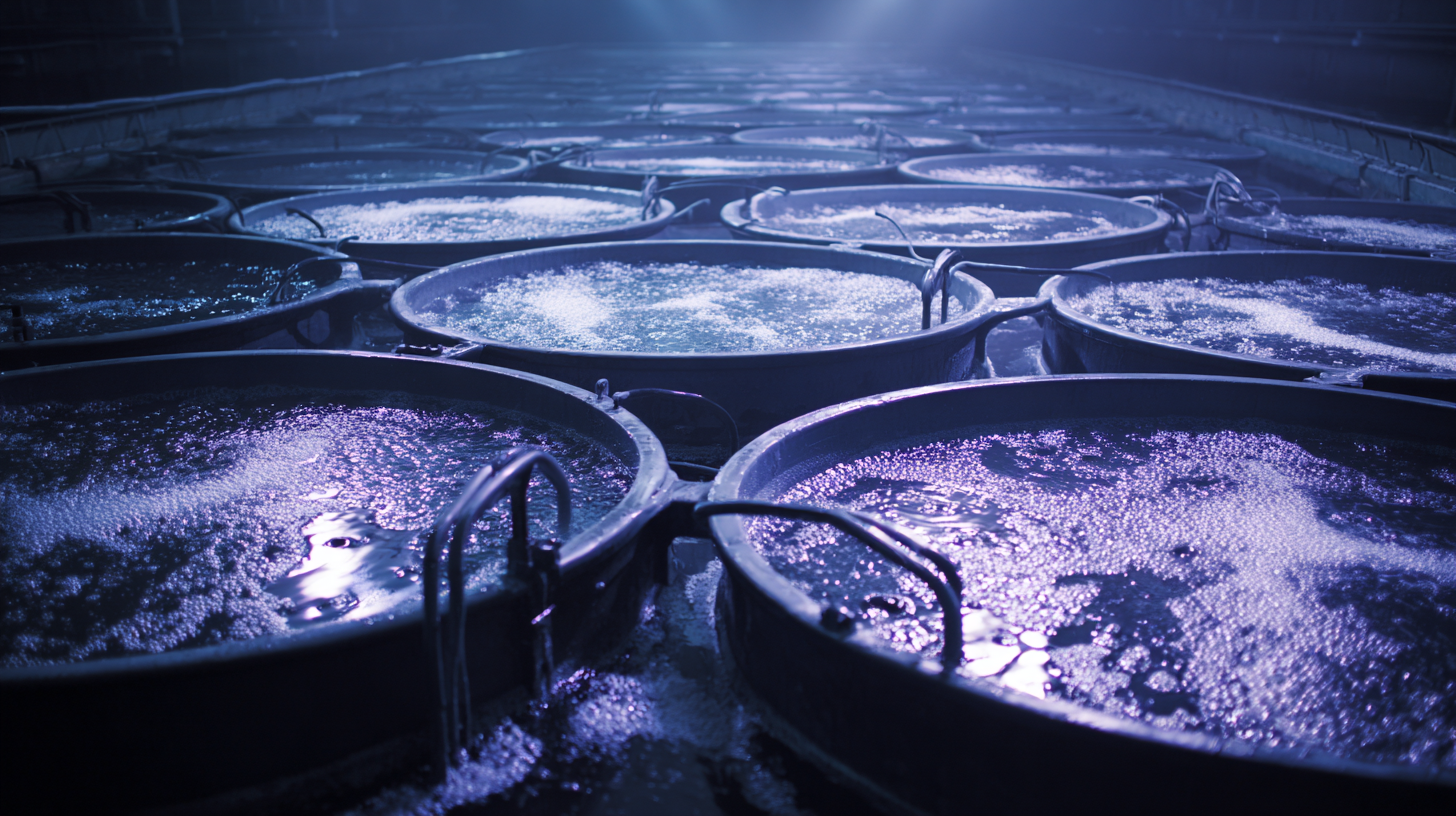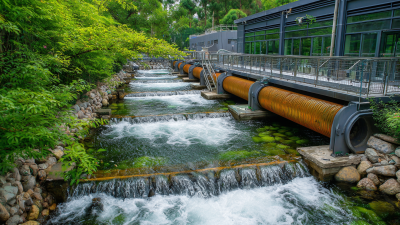 +86 13600513715
+86 13600513715



 Bubble Disc Diffusers have emerged as a crucial technology in enhancing aeration efficiency within aquaculture systems. According to a report by the Food and Agriculture Organization (FAO), global aquaculture production reached 114.5 million tonnes in 2019, emphasizing the growing need for efficient oxygen management to sustain aquatic life and optimize productivity. The optimal aeration achieved through the use of Bubble Disc Diffusers can significantly reduce operational costs while improving the growth rates of aquatic species.
Bubble Disc Diffusers have emerged as a crucial technology in enhancing aeration efficiency within aquaculture systems. According to a report by the Food and Agriculture Organization (FAO), global aquaculture production reached 114.5 million tonnes in 2019, emphasizing the growing need for efficient oxygen management to sustain aquatic life and optimize productivity. The optimal aeration achieved through the use of Bubble Disc Diffusers can significantly reduce operational costs while improving the growth rates of aquatic species.
Additionally, a study published in the Journal of Aquaculture Research found that employing Bubble Disc Diffusers in fish farming can increase dissolved oxygen levels by up to 30%, thereby enhancing overall system performance. In light of these benefits, understanding the scientific principles behind Bubble Disc Diffusers is essential for aquaculture practitioners aiming to maximize their yield and maintain environmental sustainability.
Bubble disc diffusers are pivotal in enhancing aeration efficiency within aquaculture systems. These devices work by dispersing air through a series of small bubbles, maximizing the surface area for gas exchange. This mechanism not only boosts oxygen levels in water but also aids in removing carbon dioxide, ensuring a healthier environment for aquatic species. According to a study published in the Aquaculture Research Journal, systems using bubble disc diffusers can improve oxygen transfer efficiency by up to 30% compared to traditional methods, leading to better growth rates in fish and shrimp.
When considering the design features of bubble disc diffusers, factors such as bubble size, material, and layout are crucial. A well-designed diffuser ensures uniform airflow and minimizes energy consumption. A 2021 report from the International Journal of Aquaculture Technology highlights that optimizing the pore size can significantly influence bubble dynamics, with smaller bubbles providing enhanced oxygenation due to their increased surface area.
**Tips:** Regular maintenance of diffusers can prevent clogging and ensure consistent performance. Additionally, it's important to monitor water quality parameters regularly to assess the effectiveness of aeration systems. Implementing variable frequency drives can also optimize energy use and adjust airflow based on real-time oxygen demands.

The evaluation of aeration efficiency in aquaculture has led to promising advancements, particularly when comparing bubble disc diffusers to traditional methods. Traditional diffusers often struggle with oxygen transfer due to the limited solubility of oxygen in water, which can lead to inefficient aeration processes. In contrast, bubble disc diffusers generate fine bubbles that enhance oxygen transfer dynamics, thus optimizing aeration performance. Experimental studies indicate that these diffusers can significantly improve the oxygenation levels in aquaculture systems, ultimately benefiting fish health and growth rates.
Tips: To maximize the benefits of bubble disc diffusers, consider the following: regularly monitor dissolved oxygen levels to adjust operations accordingly, and pay attention to the maintenance of the diffusers to ensure they function efficiently. Additionally, testing different bubble sizes can help tailor the aeration process to specific aquaculture settings, enhancing overall system performance.
Innovations such as membrane bubble aeration units show promising results in both lab-scale and full-scale systems. By fine-tuning aeration techniques, stakeholders in aquaculture can adopt more sustainable practices that not only enhance productivity but also minimize environmental impact. As the demand for aquaculture continues to rise, efficient aeration will play a crucial role in optimizing resource use while maintaining the health of aquatic ecosystems.
| Method | Oxygen Transfer Rate (kg O2/h) | Energy Consumption (kWh/kg O2) | Bubble Size (mm) | Installation Cost ($) |
|---|---|---|---|---|
| Bubble Disc Diffuser | 20 | 0.5 | 2-3 | 500 |
| Traditional Aeration System | 15 | 0.7 | 4-5 | 400 |
| Fine Bubble Aerator | 25 | 0.4 | 1-2 | 600 |
The efficiency of aeration in aquaculture systems significantly depends on the size and distribution of the bubbles generated by bubble disc diffusers. Smaller bubbles have a larger surface area to volume ratio, which enhances gas exchange, allowing for more oxygen to dissolve in the water. This is crucial in aquaculture, where optimal oxygen levels are essential for the health and growth of aquatic organisms. Moreover, smaller bubbles remain suspended in the water column for a longer time, facilitating better distribution of oxygen throughout the system and minimizing dead zones.
In addition to bubble size, the distribution pattern of bubbles plays a vital role in achieving effective aeration. Uniform distribution can lead to enhanced flow dynamics within tanks or ponds, ensuring that every aquatic organism receives adequate oxygen and nutrients. Uneven distribution can result in localized areas of low oxygen concentration, which can stress fish and other aquatic life. Thus, understanding the interplay between bubble size and distribution helps aquaculturists optimize their aeration systems, ultimately leading to improved productivity and sustainability in aquaculture practices.
Aeration plays a critical role in maintaining optimal water quality in aquaculture systems. The effectiveness of bubble disc diffusers in enhancing aeration efficiency can significantly influence the health of aquatic organisms. Studies indicate that adequate dissolved oxygen levels—typically between 5 to 7 mg/L—are essential for the growth and survival of fish and shrimp. Insufficient oxygen can lead to stress, reduced growth rates, and even mass mortality in aquaculture environments (FAO, 2021). Furthermore, well-aerated water can help control harmful substances, such as ammonia, which is particularly detrimental to aquatic life when levels exceed 0.02 mg/L.
**Tips:** To maximize aeration efficiency, consider regularly monitoring oxygen levels to ensure they remain optimal for your specific species. Additionally, maintaining a balanced feed regimen can minimize waste and promote better water quality, reducing the burden on aeration systems.
Integrating advanced aeration techniques, such as bubble disc diffusers, not only improves oxygenation but also enhances water circulation, stabilizing temperatures and nutrients in the aquatic environment. A report by Aquaculture Research in 2022 highlights that farms utilizing efficient aeration systems reported up to a 20% increase in shrimp yields, demonstrating how carefully managed aeration directly correlates with productivity.
**Tips:** Choose the right type of diffusers based on your water body’s size and aquatic species. Regularly cleaning and maintaining aeration equipment also ensures long-term efficiency and effectiveness.
This chart shows the comparison of key water quality parameters in aquaculture before and after the implementation of bubble disc diffusers for aeration. Enhanced aeration significantly improves dissolved oxygen levels while reducing harmful ammonia concentrations and maintaining optimal pH levels.
Bubble disc diffusers are revolutionizing aquaculture by significantly enhancing aeration efficiency. With advancements in bubble disc technology, these systems are able to produce a finer and more uniform air distribution, resulting in improved oxygen transfer rates. This innovative approach not only optimizes the health and growth of aquatic species but also contributes to the sustainability of aquaculture practices. By reducing energy consumption and minimizing nutrient wastage, bubble disc diffusers align with modern eco-friendly aquaculture goals.
**Tip:** To maximize the benefits of bubble disc diffusers, ensure proper positioning and maintenance of the diffusers to maintain consistent airflow and minimize clogging. Regular inspections can help sustain optimal performance.
The latest innovations in bubble disc designs include the use of advanced materials and engineering techniques that enhance durability and performance. These improvements lead to longer operational lifespans and lower maintenance costs, making them a cost-effective solution for aquaculture operations. By integrating smart technologies that allow for real-time monitoring and adjustments, aquaculture facilities can better manage their aeration systems, ultimately fostering healthier aquatic environments and more robust yields.
**Tip:** Consider investing in automated monitoring systems to continuously assess and adjust aeration requirements, ensuring that your bubble disc diffusers operate at peak efficiency for the specific needs of your aquaculture setup.







